Liz Randol
“A nation is not conquered until the hearts of its women are on the ground. Then it’s finished; no matter how brave its warriors or how strong their weapons.”
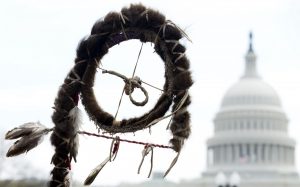
A Native American prayer stick is held near the capital during a Keystone XL protest in 2014 (Credit: AP Photos/Manuel Balce Cenata).

The Standing Rock Sioux Tribe has been joined by supporters, many from other Indigenous tribes from all around the world, in their struggle against one of the many oil pipelines that threaten drinking water supplies for the Sioux and others downstream on the Missouri River. In yet another example of environmental dumping on poor, often indigenous communities, the pipeline from the Bakken oil shale basin was originally slated to go through Bismarck.
The route was changed in response to protests by more entitled White people, and rushed through this alternate route, without the required study to determine the potential ancestral graves or cultural treasures in the sacred places that would be desecrated. These graveyards and sacred places and unknown numbers of cultural treasures were destroyed by the Energy Transfer Partners’ bulldozers as soon as they were identified.
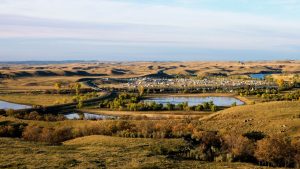 Looking north over Oceti Sakowin and Rosebud camps. (Credit: Alexandra Sanguinetti, Vogue)
Looking north over Oceti Sakowin and Rosebud camps. (Credit: Alexandra Sanguinetti, Vogue)
This is a story of the resistance to the destruction of the land and water of the Lakota/Dakota Sioux, who own the Standing Rock Sioux Reservation and the treaty lands from the Treaty of 1851. It is a story of one in a long string of betrayals by the federal government, first under Obama, and then under Trump, the kleptocrat president who stands to benefit financially from the pipeline being rammed through by Energy Transfer Partners, a campaign donor.
Some of the women spiritual leaders in this Resistance continue to lead it, though the camps were violently destroyed by county, state, and federal police on February 22. The camps were created on land claimed as private property by one of these women, LaDonna Brave Bull Allard, a direct descendant of Sitting Bull. For some reason, contracts made with Indian nations do not seem to hold the gravity of contracts made with other nations. We can all wonder why that might be.

Credit: Nat’l Geographic
In these times of changing perceptions, more and more people are awakening to the implicit bias on the part of the mainstream corporate media, pertaining to many issues, from global warming/climate change to Standing Rock to Syria. Much like the burgeoning candidacy of Bernie Sanders in the 2016 election, the growing camps and protest at Standing Rock were studiously ignored by corporate media as long as they could get away with it.
The tribe has filed a lawsuit alleging that the Dakota Access Pipeline violates federal law, including the National Historic Preservation Act, and should have been subject to an Environmental Impact Statement at the time, that the pipeline threatens the water supply to the tribe and that there was not adequate consultation with the tribe as required by law. In an initial June 2017 ruling, a federal judge found that the pipeline go-ahead had not received an adequate environemntal vetting.
A UN commission has certified civil rights violations against the Natives and other Water Protectors by Morton County authorities. Strip searches and holding Water Protectors in dog kennels and other degrading practices were routine by the Morton County police. TigerSwan mercenaries were also active against the Water Protector camps.
This is how brazenly racist the climate is in the Dakotas, where crimes against Indians routinely go unpunished, from rapes of Indigenous women in and around the Bakken basin “man camps” to the trampling of property rights – on the Lakota Nation’s treaty land – where the pipeline is slated to run.
There is much talk here of intergenerational trauma, the trauma held in the DNA of Native peoples, and how to heal it. This is trauma that comes from centuries of betrayals, peaceful villages–their crops burned, their people subjected to rape, torture, mass murder of women, children and unarmed men by armed settlers, backed by a U.S .military led in its genocidal rampages by the Presidents we see on Mount Rushmore and our dollar bills. The names of mass murderers are inscribed on our schools and streets, and celebrated in our history books.
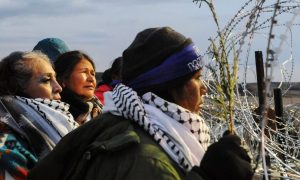
LaDonna Brave Bull Allard at far left (Credit: CounterCurrent News).
At Standing Rock the women often led the struggle, as spiritual leaders (sometimes in combination with the men), as leaders of prayer circles, as oral historians who recited the ancient stories of power, most often as the unsung heroes who saw a need and filled it, who saw that sweat lodges needed to be built and put the call out for that to happen. Women were often the ones who maintained a climate of peace and nonviolence and made sure that peace prevailed, within the camp, if not between the camp and the outsiders.
Outside the camp, Energy Transfer Partners private security, police from Morton County, North Dakota, and later from surrounding states did battle with a peaceful people, utilizing first dogs, mace, and rubber bullets, and later water cannons in freezing temperatures to attempt to intimidate the Water Protectors into leaving. It didn’t work.
Carol Ann Roan-Dennis, retired, from Seattle went to visit the camp for a month or so, in September, and then went back again in December. She spoke to me about the prayers, ceremonies, the way of life practiced at the camp.
“I was there in September, the salad days…. There was calm, serenity all around me. It was well-organized, clean; everyone was respectful. An adult crowd of like -minded people, there for a common reason. The spirituality was so strong, it was compelling. It permeated the camp.
The love and forgiveness for what had happened. And prayers, every day – prayers for what had happened a few days before, when the people were attacked by the police and dogs. It was totally different from White culture. No anger.
The women there prefer skirts. They identify with the power of the feminine – of being a woman. There were prayer ceremonies all the time. Every day, sometimes several times a day. We would pray and then wait for a sign, and then act on it.
Woman is the giver of life,. men went out and hunted; women did everything else. Stripped poles for tipis, took care of babies, men, grew food, Everything. Women ran the community.”
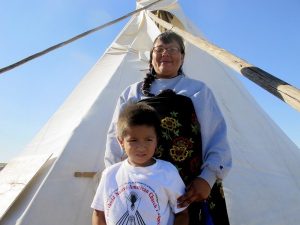
A Lakota Sioux and her 5-year-old son pose for a photo at a protest camp erected to halt the construction of the Dakota Access Pipeline (Credit: AP Photo/James MacPherson)
“There is a section for the elders to sit around the campfire, and they were highly respected, both men and women. Women speak more than the men do on most occasions. The women rally the people. They pay more attention to the old ways, the old traditions. And they spoke the histories.
LaDonna Allard was there. The women were strong spiritual leaders. I learned a lot from listening to them. The men too. We’d be hanging on every word, because of the power. The words were beautiful, poetic, peaceful. No animosity in the words about the people doing the oppressing…
Everything I have ever read in the Billings or Bismarck papers was completely anti-Native. I was there and the way they reported it all was lies, twisted to be prejudicial against the Natives, vs the truth I experienced.”
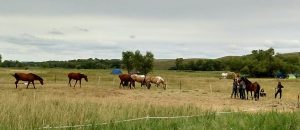
The Horse Corral where we camped, very peaceful.” (Credit: Carol Ann Roan-Dennis).
“After we left, we all ached to be back there. That’s how balanced it felt, peaceful, in total harmony. And now – to hear the slanderous lies about the Native people. The reality is they are a beautiful, a peaceful and poetic people.”
This report comes from Lana Ishka, an alternative healer from Portland who worked in the Healers’ Tent:
“On my third day, I was volunteering in the healer area when a Native man drove up and made an announcement calling for all the medic women to come out. He told us that the grandmothers are calling for a sweat lodge for the women, especially those that have trauma. He was just the messenger. He asked us all to gather at the sacred fire at a certain time. We were told to wear long skirts. At the sacred fire, this man introduced one of the grandmothers.
The grandmothers asked that men be stationed on the perimeter of the sweat lodges to protect us. As, in the past, the police had interrupted one (or more?) sweats by coming in and pulling people out.
The ceremony began as we sat on the ground and watched three grandmothers bless tobacco and smoke their pipes. We were told it was important to witness this. I think there were a total of six grandmothers and each one led a sweat. Inside the sweat, we were told stories and reminded that we are connected to all our relations.”

A camper at Oceti Sakowin raises a bundle of wild sage. Hundreds of flags representing tribes, nations, and allies from all over the world line the entrance road to Oceti Sakowin camp. (Credit: Alexandra Sanguinetti, Vogue)
Inside the Movement to Stop the Dakota Access Pipeline
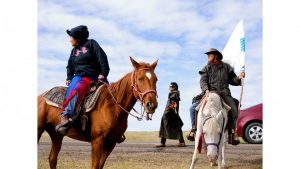
Environmental organization Honor the Earth begins a five-day “spirit ride” to raise awareness about the dangers of the Dakota Access Pipeline. Pictured at far right: Lorna Hanes. (Credit: Alexandra Sanguinetti, Vogue)
From an article in Vogue by Rebecca Bengal (Nov. 22, 2016)
“By August, there was a “spirit” camp, Rosebud, near Sacred Stone, and many camps within camps, to accommodate a population that had swelled to at least 3,000. Drones, helicopters, and planes made daily menacing swoops in the sky. Another large camp, Oceti Sakowin, or Seven Council Fires, named for the seven bands of the Sioux people, was set up across the Cannonball River. The camp ran a school for children and medic tents and held daily meetings and direct-action trainings. Kitchens served three meals a day to hundreds. Handmade signs went up banning drugs, alcohol, and weapons, and offering instruction in nonviolent civil disobedience principles. They called themselves water protectors, rather than protesters. They referred to the pipeline as the Black Snake, in keeping with Lakota prophecy. A row of flags, representing the hundreds of tribes, nations, and allies, lined the main road.
…The day after the Standing Rock Sioux tribe filed papers in federal court identifying sacred burial grounds and cultural sites along the pipeline’s path, Dakota Access sent bulldozers to some of those locations, and water protectors met them there, Democracy Now! reported. Journalist Amy Goodman narrated as the show’s camera zoomed in on stinging eyes and lunging dogs, one dog’s mouth red with blood. A warrant was issued for Goodman’s arrest.”
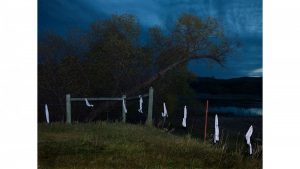
Prayer Ties on a fence at Rosebud Camp. (Credit: Alexandra Sanguinetti, Vogue)
“Ceremonies dominated the days and nights. Horseback riders were blessed and smudged with tobacco as they headed for Honor the Earth’s five-day spirit ride along part of the pipeline’s path. The Pascua Yaqui tribe arrived from Tucson and performed a traditional deer dance. A contingent of Mardi Gras Indians cooked gumbo for hundreds and hosted a music jam in their tepee that lasted until dawn.
Ta’Sina Sapa Win, a 24-year-old single mother from the Cheyenne River tribe, pulled down her shirt and showed me a still-purple slash-like wound, from a DAPL security dog that she said had bitten her breast five weeks before. “After that dog bite, it didn’t do nothing to me,” she said. “They can say it was adrenaline all they want, but to me it was spiritual. I was being guided by my grandma and my auntie.”
It was not unusual for people at Standing Rock to speak in spiritual terms. I spent long hours with teenagers, mothers, and grandfathers who repeatedly invoked their ancestors, who intimately, openly described the difference between inherited and fresh trauma, and how they were turning to traditional ways to heal.
On a bright Sunday morning, I sat with LaDonna Brave Bull Allard, the Standing Rock Sioux historian who had allowed the first tepees to stand on her land, under cottonwoods at Sacred Stone. Allard grew up here; now she watched over teams of campers who were peeling tepee poles and framing longhouses for winter. “We are expendable people,” Allard told me. “We always have been. But we have the answers on how to save the world. We have the answers on how to live with this earth. We have to stand up and share that knowledge.”
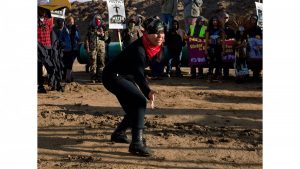
A dancer performs at a ceremony for the meeting of the Eagle and the Condor. (Credit: Alexandra Sanguinetti, Vogue)
“We’re here to protect our treaty land.” They prayed again. This was a ceremony, he said, for the meeting of the Eagle and the Condor, tribes representing the North and South. Two people in enormous Eagle and Condor masks stood at the circle’s edge. Aztec dancers in ponchos and skirts danced, bells jingling at their ankles, stirring up clouds of dust and dirt. One in a bright spiky headdress took the bullhorn to pray to Mother Earth “for forgiveness for what the two-legged have done to this land….”
“A fleet of police cars and a sniper van appeared on the horizon, and soon officers wearing face shields and carrying billy clubs, some armed with rifles, marched down to the site in platoon-like formations of 20 and 30, ordering everyone back to the hillside… A caped singer from the North walked solemnly between the police and the protectors, beating his drum. Some of the Aztec dancers began dancing again, on a little wooden bridge. Other riot police mounted in the distant hills. In the foreground, a 3-year-old named Havana learned how to flash a peace sign.”
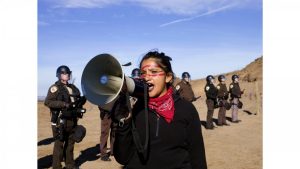
Credit: Alexandra Sanguinetti, Vogue
“Andreanne Catt, 17, her face painted with streaks of lipstick, picked up the bullhorn and spontaneously led the crowd in a call and response. “We stand!” Catt shouted. “We stand!” “For our brothers!” “For our brothers!” “And our sisters!” “And our sisters!” “Mni wiconi!” she called out. “Water is life!”
Inside the tepee, Theresa Black Owl again took out her canupa and passed it around. “I was trying to relax because one of the girls in the tepee was really scared. Her hands were just shaking,” she told me later. Most Native American ceremonies were illegal in the United States until 1978, when the American Indian Religious Freedom Act was passed. Practicing them was its own form of resistance. “When I grew up, it wasn’t safe to be an Indian.”
From a Democracy Now interview with Winona LaDuke, by Amy Goodman (Sept. 12, 2016)
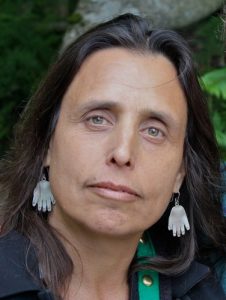
Credit: U Penn.
“I’ve seen people from .. from Wounded Knee in 1973. I’ve seen people I worked with in opposing uranium mining in the Black Hills in the 1970s and ’80s… I mean, I’ve been at this a while… And there are a lot of people that just do not believe that this should happen anymore in this country, that are very willing to put themselves on the line, non-Indian people, you know, as well as tribal members, and they are here. And it is a beautiful place to defend…
This matters because it’s time to move on from fossil fuels… this is the same battle that they have everywhere else…each week, there’s some new leak, there’s some new catastrophe in the fossil fuel industry, as well as the ongoing and growing catastrophe of climate change. The fact that there is no rain in Syria has directly to do with these fossil fuel companies…
..what you get is intergenerational trauma, is what it is known as, historic trauma. And other people have it. But you have a genetic memory,…every day you wake up, and you see that your land was flooded… you got a roadblock, that the white people put up, coming into your reservation. And every day you go out there, and you look at your houses, and you see that you’ve got crumbling infrastructure, and nobody cares about it. And you’ve got a meth epidemic, and you’ve got the highest suicide rates in the country, but nobody pays attention… so you just try to survive.”
“…that $3.9 billion pipeline, these guys don’t need a pipeline. What they need is solar. What they need is wind. Look at this wind…—they have like class 7 wind out here. What they need is solar on all their houses, solar thermal. They need housing that works for people. They need energy justice… They call this energy independence, you know, shoving a pipeline down people’s throats, so that Canadian oil companies can benefit, and, you know, a bunch of people can—the world can worsen. That is not energy independence. Energy independence is when you have solar. Energy independence is when you have wind.”
Hawaii Tribune interview with Hawaiian activists (Sept. 9, 2016)
The struggle to protect Mother Earth has resonated all across the globe. This Hawaii-based paper interviews activists from Hawaii who traveled to support the Water Protectors in North Dakota. They saw reflections of the same struggle to protect their own sacred places, such as Mauna Kea, threatened by the proposed Thirty Meter Telescope (TMT) installation.
“It reminded me of our stand for Mauna A Wakea last year,” Kyser wrote, when explaining why he made the long journey. “The same emotions were hitting me, tears were shed as I was looking at all the (social media posts).”
Pua Case of Waimea said she was leaving Thursday with her daughter, Hawane Rios, to travel to Standing Rock. She said some Native American protesters who are at the reservation supported their efforts to stop TMT construction, and now they are returning the favor.”

Auntie Pua and daughter Hawane Rios at Standing Rock (Credit: Facebook public photos)
“They have put out a call for us to come,” said Case, a party in the TMT contested case hearing. “If someone stands for you, you stand for them as well.”
“Just like home guys,” said Kyser, regarding the upcoming court decision in a video posted on the Facebook page “Na‘au News Now.”
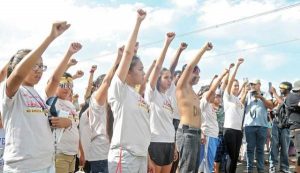
Approximately two hundred people from across the country came to support the Water Protectors in August 2016 at the pipeline site.
Indian Country Today report: Indigenous Leaders From Ecuador Come to Standing Rock (Sept. 9, 2016)
“Indigenous leaders from Ecuador joined the protectors at Standing Rock recently to show solidarity and share information, as their community has had some victories against oil companies and politicians in the past few years….All of the Kichwa visitors are activists who have participated in the decade-long fight against multinational oil companies and the Ecuadorian government’s efforts to drill in their Amazonian community known as Sarayaku. The Kichwa contingent has been very active in the struggles in Ecuador.
“We came from the Amazon jungle with a message of strength and solidarity for the Sioux,” Viteri said. “My people are very conscious, because of our history and our tradition, just like the tribes here, of our connection with nature, with Mother Earth; we know that this is what gives balance to life here on Earth. The transnational corporations, like those trying to build this oil pipeline, are blind because they don’t understand the language of nature.”
“In the name of all the children, elders, women, the birds, the large and small animals that depend on water to survive, the Kichwa people extend a greeting,” he said, “a sacred greeting of respect for nature and for the life of all the peoples of the North, because we know that if water is destroyed, life on Earth will end.”

Left to Right: Eriberto Gualinga (Sarayaku), Franco Viteri (Sarayaku), Kandi Mossett (Indigenous Environmental Network, Fort Berthold), David Archambault II (Standing Rock Sioux Tribal Chairman), Nina Gualinga (Sarayaku), and Leo Cerda (Kichwa, on Amazon Watch staff).
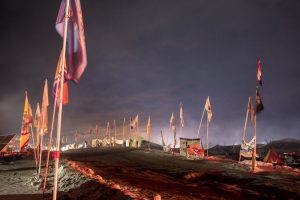
Jezebel interviews with women who built Standing Rock movement (Dec. 8, 2016)
Anna Merlan of Jezebel interviewd “the Brave, Audacious, Astonishing Women Who Built the Standing Rock Movement.” This is Joye Braun (Cheyenne River Sioux):
“Women, we’re life-givers,” she says. “Whether it’s about the Keystone XL pipeline, [proposed Canadian pipeline] Energy East, uranium mining, mountaintop removal, it all affects water. We start life in water, in the womb.”
“In our culture, those who have epilepsy can see things that no one sees,” she explains. “She was telling me that the snakes were coming.” Her daughter saw “the water on fire, and the earth on fire,” and a line of people marching against the snakes.
“The women were standing in front,” she says. “And then behind the women were the men and behind the men was the nachan [chiefs] and behind them were the children. And behind the children were the animals. Four legged and winged and swimming things that don’t have a voice.”
… “Lots of people had dreams and visions out there where the women are in front,” she said, quietly, from her yurt, as the snow continued to fall. “It has always been the women.”…
“LaDonna Brave Bull Allard, an enrolled member of the Standing Rock Sioux and the former tribal historian, owns the land that Sacred Stone Camp rests on, one of the water protectors’ largest encampments. Allard’s family has been in North Dakota since the 1800s, and she’s been a driving force in the Standing Rock campaign. “I come from a long line of bigmouthed women,” she says. “My grandma, my mom—they always stood up.”
The pipeline was her time to stand up, she adds. “I’m the closest landowner. It’s me who’s first facing the devastation of the pipeline, having to face those people.”
“When we first opened the camp, I said anybody was welcome, anybody who would stand with me. I don’t care how you pray, how you look, as you long come stand and pray.”
Those people, she says, plan to stay “for the long haul, until the pipeline is gone. So we still have a lot of work to do. Someone asked me the other day when is this ended? When every pipe is out of the ground and the work is ended.”
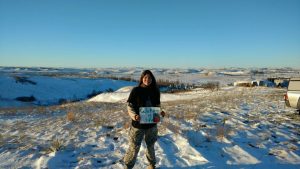
Marisa Van Zile at Standing Rock (Credit: Marisa Van Zile).
Here are more of the women who came from far and wide to support Mother Earth and the tribes, the Indigenous whose kuleana (Hawaiian for sacred duty) is to love and protect the Earth (‘aina in Hawaiian), and in return she will love and support all life.
“Native women were also among the thousands of veterans who descended on the camp recently to support the water protectors. Marisa Van Zile lives in Michigan and is an enrolled member of the Sokaogon Chippewa band of Lake Superior Indians [in Wisconsin]…
“My tribe battled these big mining companies for almost three decades. I know what this feels like. I was born into this.” As such, she’s used to companies finding ways around the law, and the government turning a blind eye.
“You can’t just take somebody’s word. You have to watch.”
Van Zile points out, too, that other Native-led environmental movements aren’t getting the attention that Standing Rock has garnered. “Indigenous people all over the world have similar battles going on, against things that are devastating the land and the water and cultures.” She points to the Wisconsin-based Ho-Chunk nation, who have been fighting to keep their ancestral burial mounds intact, or mining under the Menominee River, damaging the ancestral lands and water of the Menominee tribe.
“Standing Rock, the Menominee River, I take them all personally,” she says.”

Vanessa Castle and her horse, Medicine Hat, from the Lower Elwha Klallam Tribe in Port Angeles, Washington (Credit: Celine Guiout).
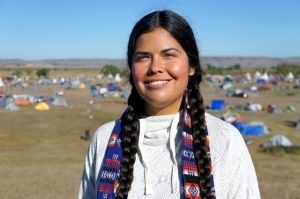
Tara Houska (Couchiching First Nation, Ojibwe, from International Falls, Minnesota)—national campaign director of Honor the Earth
Sierra interview with Tara Houska (Oct. 2016)
Tara Houska, National Campaign Director for Honor the Earth, explains,
“We’ve got people who are historic enemies camping alongside each other, learning to live together and be together in this space…security uses dogs and mace on Native American women and children protecting sacred sites being destroyed right in front of them, while North Dakota police are watching. People are out exercising their first amendment rights and being met with militarized response in incredibly dangerous situations: guns drawn, mace, planes flying overhead…We hope grassroots media gets the real message out, that we’re gathered here in unity and prayer to stop this from happening.”
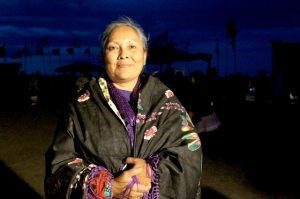
Leanne Guy (Diné, from Navajo, New Mexico)—executive director of the Southwest Indigenous Women’s Coalition Emily Arasim
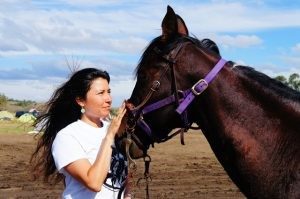
Deezbaa O’Hare (Diné, Irish/Swedish residing in Oakland, California)
Kara Maria Ananda interviews with the Women of Standing Rock (Nov. 3, 2016)
There is a new Feminine Spiritual leadership on the planet, women working together to lead their peoples in a cooperative movement – a new way of life. This is Nahko Bear, speaking about Winona LaDuke and Indigenous women leaders at Standing Rock:
“Standing Rock is an unprecedented movement of people from global tribes and backgrounds coming together to stand up in prayer for the Earth. This is happening because of the strength and commitment of many dedicated women who have started and sustain these efforts. The healing of our waters and earth has a new feminine spiritual leadership, that is guiding an ecologically focused partnership model of living. ”
“One of the most beautiful things I feel right now, is that you see these amazing, empowered women who are stepping up and really reminding us young men, and men in general, that our role is to let the women lead, and yet, we’re their protectors and we stand side-by-side, but the women are supposed to lead with their hearts.”
– 
Daphne Singingtree, a Traditional Healer & Midwife, at Standing Rock (Credit: Jade Beall)

Carol, from the Paiute Tribe (Credit: Jade Beall)
Women’s Health and Ecology
Democracy Now interview with midwife Carol Reyes at Standing Rock (Oct. 18, 2016)
“Many midwives, herbalists and healers have traveled to Standing Rock to set up health clinics and support for the camps. Women healers are speaking up about the vital nature of traditional and sacred reproductive health care and birthing support for women.”
“Sovereignty for indigenous people is only going to come about through the support of women and women’s health, in the same way that we defend and protect Mother Earth is the same way that we need to defend and protect women and the next generations of children being born.”

“The first baby was born at Standing Rock in September and has been named Mni Wiconi, meaning Water Is Life in Lakota, also the words seen all over Standing Rock and that express the heart of this movement. She was born naturally without medical assistance, a sign of great blessings upon the camp.
New birthing tipis have been constructed for the more expected babies to come. In the heart of the sacred lands under attack, new life is coming forth, dedicated to continuing the protection of water and health. “
National Public Radio interviews (Nov. 22, 2016)
“If you don’t know very much about Native American people, you wouldn’t understand that this is something that’s kind of natural to us,” said Hopkins, who is enrolled in the Sisseton Wahpeton Oyate Nation and was born on the Standing Rock Reservation. “When we have ceremonies, we do camps like this. It’s something that we’ve always known how to do, going back to pre-colonial times.”
“There are no rights being violated here that haven’t been violated before.” said Kim Tallbear, a professor of Native Studies at the University of Alberta, who for years worked on tribal issues as an environmental planner for the U.S. Environmental Protection Agency and the Department of Energy. Those violations, she said, have taken two forms: long-term disregard for indigenous land rights and a “bureaucratic disregard for consultation with indigenous people.”
When she sees images of police using pepper spray and water cannons or security guards unleashing dogs on Standing Rock protesters, Tallbear said, she isn’t shocked. “I’m, like, oh yeah, they did that in the 19th century, they did that in the 16th century,” she said. “This is not new. … The contemporary tactics used against indigenous people might look a little bit more complex or savvy, but to me, I can read it all as part of a longstanding colonial project.”
“Maybe for non-Natives who thought that the West was won, and the Indian Wars were over, and Native people were mostly dead and gone and isn’t that too bad – now, they’re like, ‘Oh wait a minute, they’re still there? And they’re still fighting the same things they were 150 years ago?’
“Yeah, we are.”
Guardian interviews: Native Lives Matter (Nov. 4, 2016)

“Prairie McLaughlin said she has daily flashbacks – “daymares” – about the police. Sitting inside a small tipi where she is camped out while protesting the Dakota Access pipeline, she took a drag of her cigarette and recounted how officers took her to a North Dakota jail last month where, she says, a group of male and female guards forcibly removed her clothes when she refused to strip in front of them.
“I’m beyond traumatized,” the 33-year-old Native American woman said through tears. But, when asked if she was prepared to keep defending the Standing Rock tribe’s water, McLaughlin’s face hardened. “Everyone needs to stand up,” she said.
Native women say they are protecting the basic human right to clean water. But for some indigenous activists, the internationally recognized movement has become a larger fight against a history of misogyny, racism and abuse by law enforcement.”
Indigenous women have long had a fraught relationship with American police – whether in the form of questionable fatal shootings or law enforcement inaction in the face of human trafficking crises and sexual assault epidemics.
“It’s always been happening,” McLaughlin said, but “people in the world see it now.”
Although indigenous rights are often ignored in the discussion of police brutality, studies have shown that Native Americans are more likely than any other racial group to be killed by law enforcement, prompting some to adopt the rallying cry, “Native lives matter”, a reference to the Black Lives Matter movement…
For native women leading at Standing Rock, police disrespect of indigenous culture and women is unsurprising.
“North Dakota law enforcement have no qualms about grabbing people and throwing them to the ground,” said Cheryl Angel, a Sicangu Lakota tribe member
“They picked out people who they thought were leaders,” said Xhopakelxhit, a Native American woman who was recently arrested during a protest. “It was outright brutal force.”
“I just felt kind of violated all because of being Native American,” said Johanna Holy Elk Face, a 63-year-old woman who was recently arrested.”
March 2017 protest in Washington DC where tipis were set up on the National Mall
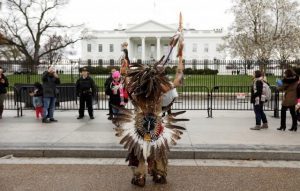





Statement from Indigenous Mexican Groups

THIS STATEMENT WAS ISSUED AND SIGNED BY HUNDREDS OF ORGANIZATIONS REPRESENTING WATER PROTECTORS AND LAND DEFENDERS OF THE COUNTRY OF MEXICO. THIS HISTORIC STATEMENT, ISSUED TO THE US EMBASSY IN MEXICO CITY, SHOWS UNPRECEDENTED UNITY FROM INDIGENOUS MEXICAN GROUPS TO SUPPORT STANDING ROCK. WE THANK YOU FOR YOUR ELOQUENCE AND PROFOUND PRAYERS OF SUPPORT FOR THE PEOPLE OF THE NORTH.
WE ARE ONE TRIBE!
“From the part of the Planet we call Mexico we raise our prayers and our voices to make them reach the Lakota people in North America. They are fighting to defend their territory against the imposition of the Dakota Access Pipeline (DAPL) –project of death which puts at risk the water of the Missouri River and the sacred sites of this original town. We condemn the repeated attacks by the US government’s security forces against the various camps that have been held since April 2016 by water protectors. These water protectors have been supported by people from all over the world, people who have traveled to North Dakota to share their word and some of them have even placed their tribe flags in solidarity with the Sioux nations.
.. We condemn and repudiate the brutal acts of violence that the Trump administration has launched against our Lakota brothers and sisters, in the same way that we have already repudiated here, in the part of the world that we call Mexico, whenever disdain and lack of respect manifest against our indigenous peoples…
The Lakota are maintaining their peaceful resistance through nonviolence. The visit of Cheryl Angel left us a message of the brotherhood and sisterhood that are built among the peoples who struggle together for a better world, erasing with it the borders that have been imposed by the financially powerful and that are being stressed by the ambition of those who pretend to dominate our Planet.
… we say to those who resist in the part of the Planet that we call the United States: that they are not alone, their struggle is our struggle, because for the protection of water, land and life there are no borders, let alone imposed ones.”
– from Cheryl Angel’s Facebook page.
